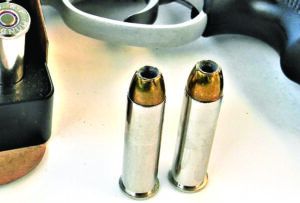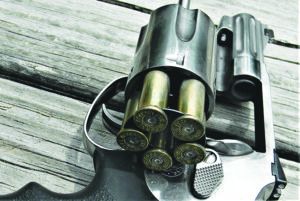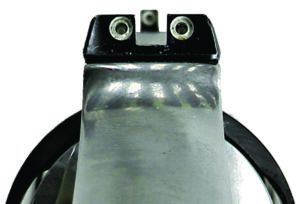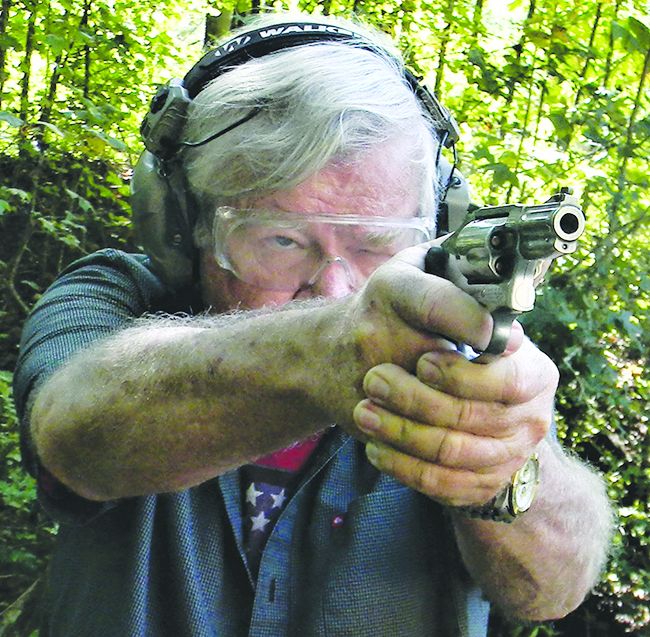Revolvers remain a solid choice for personal defense. Many citizens decide they need a handgun to protect the homestead or to carry concealed, and they often choose a simple revolver. Folks hiking and camping also like to have a handgun handy that has the utility to take on feral dogs and aggressive big cats. Not to mention the epidemic of crime along trails. For many who are unable to take an immersion class in handgunning, the revolver, with its simple manual of arms, is a good choice. But revolvers are not found only in the safes of beginners. Many experienced handgunners favor a revolver for certain chores. As a backup handgun, while camping, or for any day of the week, the revolver is a fine choice. Let’s find your best buy among three good handguns we recently tested.
Our first wheelgun was the Charter Arms Boxer 53620 38 Special, $349. Charter Arms rose to success during the Vietnam War by offering affordable but reliable revolvers at a fair price. Our research indicates it was either Colt or Smith & Wesson revolvers or cheap imports without affordable, reliable revolvers in the middle price range before Charter Arms came along. Charter Arms introduced what was then billed as the lightest steel-frame revolver. Charter accomplished this by designing a steel-frame chassis surrounded by an aluminum receiver, with aluminum used in the areas that are less stressed or that have reduced load bearing. Also, Charter Arms produced one of the first transfer-bar revolvers manufactured in America.
Next up were two revolvers chambered in 357 Magnum, but which also fire the 38 Special, the first being a Smith & Wesson Performance Center Pro Series Model 640 178044, $909. The Smith & Wesson 640 Pro is a concealed-carry double-action-only revolver. The hammer is concealed beneath the characteristic humpback frame. This revolver features a 2.125-inch-long barrel, yet it is heavier than the others at 22.5 ounces, mainly because of its stainless-steel frame and barrel.
The third gun of this trio and the second 357 Magnum is the Taurus Defender 605 2-60539NS, $467. Taurus has upgraded several of its revolvers to the Defender status. This is the same revolver as far as action, chambering, and capacity go, but with a 3-inch barrel compared to the shorter 2-inch barrel and with hand-filling grips. A tritium front sight is also added. The 856 six-shot 38 Special is the first of the Defender series, but the Defender 605 is a 3-inch-barrel five-shot 357 Magnum revolver with an exposed hammer. The revolver is more like the Smith & Wesson 640 Pro than the Charter Arms Boxer.

Before firing the handguns, we rounded up several choices of 38 Special ammunition. The majority of ammunition fired was Remington 130-grain full metal jackets. We also used Federal 158-grain Train & Defend, a standard-velocity lead hollow point. These are practice loads at low velocity, with low recoil. We also used two modern 38 Special defense loads, the Federal 120-grain Punch and the Hornady 125-grain XTP. We fired the Remington and Federal non-expanding loads in a combat course, using 25 rounds of each load in each revolver at 5, 7, and 10 yards. We fired for accuracy from a bench at 25 yards using the Federal 158-grain RNL load and the Hornady and Federal defense loads. Here’s what we thought of each handgun in more detail.
Gun Tests Grade: A (OUR PICK)
$909
The Smith & Wesson 640 Pro doesn’t use the company’s controversial action lock, which isn’t desirable on a hard-use Magnum revolver. While problems are few on most wheelguns, one is too many in personal defense. The most overwhelmingly superior feature of the Smith & Wesson 640 Pro are the sights. These are high-profile sights that would be suitable for any self-loading pistol and are uncommon on a revolver. In this case, the sights are self-luminous iron sights, aka night sights, which are a great addition to this personal-defense handgun.
| Action Type | Double action only |
| Overall Length | 6.6 in. |
| Barrel | 2.13 in. |
| Sight Radius | 3.75 in. |
| Overall Height | 4.3 in. |
| Maximum Width | 1.4 in. |
| Weight Unloaded | 22.0 oz. |
| Weight loaded | 24.1 oz. |
| Cylinder Gap | 0.045 in. |
| Capacity | 5 |
| Frame | Polished stainless steel, J Frame |
| Barrel & Cylinder | Polished stainless steel |
| Frame Front Strap Height | 2.2 in. |
| Rear Strap Height | 3.8 in. |
| Grip | Pebbled rubber |
| Grip Thickness Maximum | 1.2 in. |
| Grip Circumference Maximum | 5.0 in. |
| Front Sight | Tritium |
| Rear Sight | Tritium |
| Trigger Pull Weight Double Action | 11.6 lbs. |
| Trigger Span | 3.0 in. |
| Safety | Internal rebound |
| Warranty | 1 year |
| Telephone | (800) 331-0852 |
| Website | Smith-Wesson.com |
| Made In | U.S. |
The grips are likewise excellent. We have never seen this type offered for sale in the aftermarket. They complement the 640 Pro by helping control recoil. They are softer than the Charter Arms Boxer grips, and while the Taurus feels similar, the Taurus does not do as good a job absorbing recoil, in our view.

This hammerless revolver offers a smooth snag-free draw and shields the internals of the revolver from grit and grime. The cylinder is cut for moon clips. We found T&K Custom moon clips to be a great addition to the 640 Pro. In side-by-side comparisons, the moon clips were much faster to recharge the gun than conventional speed loaders. Of course, the 640 Pro may also be loaded with standard speed loaders, and it works fine without moon clips.
The snubby barrel is fluted. While these flutes don’t serve a clear purpose, they add a bit of style to the 640 Pro. While the barrel isn’t appreciably longer than the usual 17⁄8-inch snubnose barrel, the 640 Pro’s slightly longer ejector rod makes for sure handling and positive ejection. It is just enough longer than the usual Chief’s Special/J-frame revolver ejector rod to clear 357 Magnum cartridge cases.
Firing the 640 with the same 38 Special loads used in the other handguns, we learned the Smith & Wesson Pro has a smooth action. Still, the action is tight, with no excess motion as was sometimes felt with the Charter revolver and felt a little in the Taurus Defender. The excellent combat sights give the Pro an edge over the simple fixed grooves in the top straps of the other revolvers. While the Charter Boxer has a fiber-optic front sight, it is no more visible than the Smith & Wesson’s front night sight, especially in dim light. The Taurus Defender also has an advantage over the Charter Arms in dim light, but not in daylight firing. The Smith & Wesson provided the best combat shooting groups. The sights, smooth action, and heavier weight all contributed to a good showing. The Smith & Wesson Pro Series 640 is clearly a formidable defensive revolver.

In firing from the bench, the revolver was handicapped because it could not be cocked for single-action fire. Double-action fire is most often used for personal defense, and the combat-firing section proved the capability of the Smith & Wesson Pro. Just the same, we fired a number of groups at 25 yards, staging the trigger, something we did not do during combat shooting. We brought the trigger back, almost breaking the sear, confirmed the sight picture, and fired. The result was some groups as small as 2.95 inches.
Our Team Said: The sights are good, but the sight picture is cramped due to a short sight radius. The high, tall backstrap made for good comfort, even when firing full-strength 357 Magnum loads. The Smith & Wesson 640 Pro would be our hands-down choice for personal defense if price is no object, but price is often an important consideration — especially if this is a second handgun, or a backup handgun. In the end, we felt the Charter Arms Boxer was the Best Buy for personal defense based on its good performance and a fair price. If you must have a Magnum, the Taurus is the Best Buy.
38 Special Range Data
We fired five-shot groups at 25 yards from a benchrest position using an MTM Case-Gard K-Zone rest. We used a Competition Electronics Pro Chrony to measure velocity. The first screen of the chronograph was 10 feet from the muzzle of the firearms. The Charter Arms Boxer and Taurus Defender revolvers were fired single action. The Smith & Wesson is a double-action-only revolver and was fired DAO.| Federal Train & Protect 38 Sp. 158-grain LSWCHP | Charter Arms Boxer | Taurus Defender 605 | Smith & Wesson PC Model 640 Pro |
| Average Velocity | 730 fps | 777 fps | 756 fps |
| Muzzle Energy | 187 ft.-lbs. | 212 ft.-lbs. | 200 ft.-lbs. |
| Small Group | 2.5 in. | 2.75 in. | 3.0 in. |
| Average Group | 3.5 in. | 3.7 in. | 4.3 in. |
| Federal Punch 38 Sp. +P 120-grain JHP | Charter Arms Boxer | Taurus Defender 605 | Smith & Wesson PC Model 640 Pro |
| Average Velocity | 901 fps | 1002 fps | 934 fps |
| Muzzle Energy | 216 ft.-lbs. | 267 ft.-lbs. | 231 ft.-lbs. |
| Small Group | 2.3 in. | 3.0 in. | 3.1 in. |
| Average Group | 2.8 in. | 4.0 in. | 4.4 in. |
| Hornady American Gunner 38 Sp. 125-grain XTP | Charter Arms Boxer | Taurus Defender 605 | Smith & Wesson PC Model 640 Pro |
| Average Velocity | 880 fps | 891 fps | 867 fps |
| Muzzle Energy | 215 ft.-lbs. | 220 ft.-lbs. | 209 ft.-lbs. |
| Small Group | 2.3 in. | 2.4 in. | 3.0 in. |
| Average Group | 3.4 in. | 3.5 in. | 3.8 in. |




























